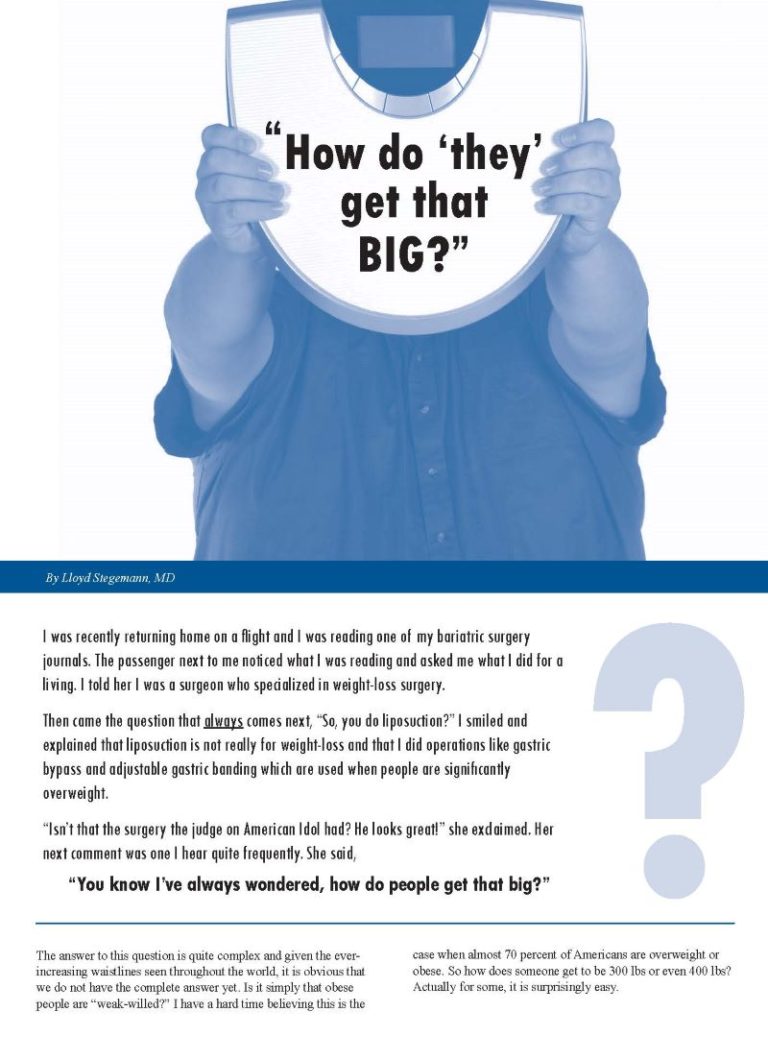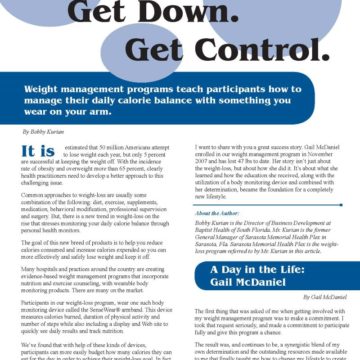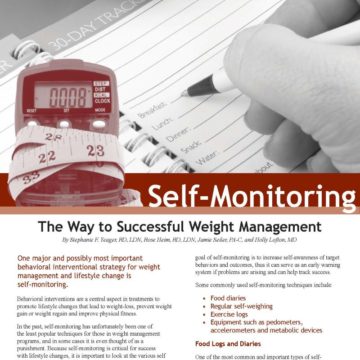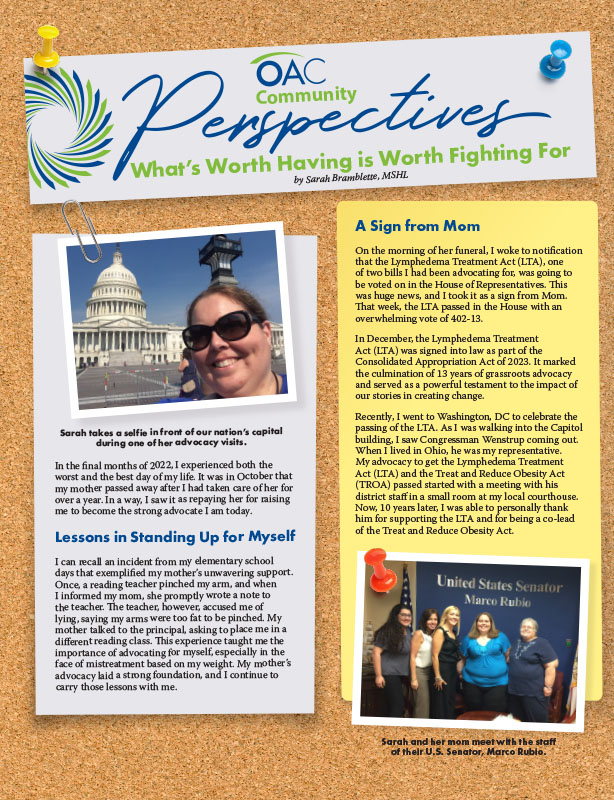"How do they get that BIG?"


By Lloyd Stegemann, MD
Spring 2008
I was recently returning home on a flight and I was reading one of my bariatric surgery journals. The passenger next to me noticed what I was reading and asked me what I did for a living. I told her I was a surgeon who specialized in weight-loss surgery.
Then came the question that always comes next, “So, you do liposuction?” I smiled and explained that liposuction is not really for weight-loss and that I did operations like gastric bypass and adjustable gastric banding which are used when people are significantly overweight.
“Isn’t that the surgery the judge on American Idol had? He looks great!” she exclaimed. Her next comment was one I hear quite frequently. She said, “You know I’ve always wondered, how do people get that big?”
The answer to this question is quite complex and given the ever-increasing waistlines seen throughout the world, it is obvious that we do not have the complete answer yet. Is it simply that people with obesity are “weak-willed?” I have a hard time believing this is the case when almost 70 percent of Americans are affected by excess weight or obesity. So how does someone get to be 300 lbs or even 400 lbs? Actually for some, it is surprisingly easy.
Genetics
As more and more obesity research is being done, the strong link between genetics and obesity is becoming increasingly clearer. We have all known people who can eat anything they want and still maintain a healthy weight. We have also known people who look at a piece of cake and gain weight. What is the difference between these two types of people?
Very likely it is due to genetic differences in their energy metabolism. At some point in the development of mankind, the ability to store fat efficiently would have given one a survival advantage. In this day of food abundance, however, this same efficiency puts one at risk of developing obesity.
Clearly, genetics alone is not the answer. While an individual may be born with a genetic composition that predisposes them to develop obesity, not all of them will become affected by obesity. I have also yet to see the following headline, “Mother Delivers 300 lb Baby!” There is a popular saying in obesity treatment that goes, “When it comes to obesity, genetics loads the gun, but the environment fires it.”
Environment
People do not become affected by severe obesity overnight. While children born with higher birth weights are at an increased risk of developing obesity in later life, most people with severe obesity were a normal weight at birth. Children are, however, quickly introduced into our obesity genic environment. Let’s take a hypothetical child and see how she might easily get to 300 lbs.
Early on this particular child is a healthy weight for her age. After puberty she notices she is “filling out” a bit. As she enters high school she notices she’s “a little chunky” but because she is very involved in athletics, she is able to maintain a healthy weight.
She graduates from high school and enters college. Due to her demanding college schedule, she finds that her meal patterns are disordered and she often just grabs something on the run. Many times what she grabs is not the healthiest choice, but it is fast and easy. Late night study sessions usually involve chips, soda and an occasional pizza.
It becomes increasingly difficult to find time to exercise and by the time freshman year is over, she gained 20 lbs. Over the summer, she is able to drop some weight by getting back to the gym and eating more sensibly. Once school starts up again, however, it’s back to the old pattern again. By the time she graduates from college, she has gained 40 lbs.
After graduation, she gets a great job in the city. She has a beautiful desk, which she sits behind for 8-10 hours a day. During her breaks, she will meet her coworkers and they will share a candy bar and soda while discussing their life events. They start different fad diets and see a few pounds come off here and there only to see them come back once the “diet” stops. December 31st, she promises to lose the 10 lbs she has gained that year.
Life continues and she meets a wonderful man whom she marries. Now with her career and a home to take care of, finding time to exercise is almost impossible. Three diets undertaken this year, 15 pounds lost, 20 pounds regained. Soon the wonderful news comes that she is pregnant.
Nine months and 50 lbs later, she and her husband welcome a little one into their lives. She hardly recognizes herself in the mirror and plans to start “dieting for real” to take the baby weight off. She starts with a vengeance and is diligent about cutting her calories and being more active. For some reason though, the weight is not coming off as easy as it used to. Soon, maternity leave is over and it is back to the “real world” of work. She finds herself getting depressed about her weight and feeling helpless to control it.
Over the course of the next several years, the established patterns continue. Diets here and there – take off five or 10 lbs, only to be replaced by 10 or 15 lbs. She wants to exercise, but finds it difficult to find the energy to clean her house, let alone go to the track and walk. She still can’t believe that at a recent doctor’s visit the scale read 302 lbs.
As she celebrates her 40th birthday, she politely avoids having her picture taken, always offering to be the photographer instead. She’s ashamed of the way she looks and fears for her health. The thought of needing to lose 130 lbs is overwhelming.
Conclusion
The scenario above has been played out by millions of people across the world. So who is responsible? It is very unlikely that we are going to be able to impact the genetic makeup of individuals in the near future; therefore, we as a society need to look at what environmental factors we can impact on to stem the obesity tide.
I believe this starts with individual responsibility, as ultimately each of us controls our calorie intake and expenditure. Still, while each individual must take personal responsibility for their weight, we as a society must also take responsibility by implementing public health policies that promote healthy eating and increased physical activity on both the state and national level.
This means, among many other things, providing funding for education initiatives, improving infrastructure such as parks and bike paths, creating tax incentives for businesses that promote a healthy workforce and providing subsidies for fruits and vegetables, which will make them more affordable for the average individual. Basically, it means dramatically changing the way we as a society operate.
Until that time comes, unfortunately, I will need to continue to operate.
About the Author:
Lloyd Stegemann, MD, is a private practice bariatric surgeon with New Dimensions Weight Loss Surgery in San Antonio, TX. He is the driving force behind the Texas Weight Loss Surgery Summit and the formation of the Texas Association of Bariatric Surgeons (TABS). Dr. Stegemann is a member of the American Society for Metabolic and Bariatric Surgery (ASMBS) and the OAC Advisory Board.
by Sarah Ro, MD; and Young Whang, MD, PhD Fall 2023 Mary, a postmenopausal woman with a…
Read Articleby Rachel Engelhart, RD; Kelly Donahue, PhD; and Renu Mansukhani, MD Summer 2023 Welcome to the first…
Read Articleby Sarah Bramblette, MSHL Summer 2023 In the final months of 2022, I experienced both the worst…
Read Article








